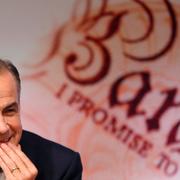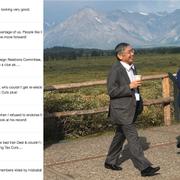
FN: Världsekonomin i behov av stora stimulanser
Världsekonomin är i behov av en global motsvarighet till de stimulanser som tog USA ur den stora depressionen på 1930-talet, president Franklin Roosevelts ”New Deal”. Det anser FN:s organ för utvecklingsfrågor, UNCTAD.
”Sju decennier senare behövs en lika ambitiös insats för att tackla de problem som följer med hyperglobaliseringen för att kunna bygga inkluderande och hållbara ekonomier”, skriver UNCTAD i sin årliga rapport Trade and Development Report, enligt AFP.
”Att bryta åtstramningspolitiken och att återigen använda finanserna för att tjäna samhällen, snarare än tvärtom, är de mest angelägna frågorna”.
New Deal
Wikipedia (en)
The New Deal was a series of federal programs, public works projects, and financial reforms and regulations enacted in the United States during the 1930s in response to the Great Depression. These programs included support for farmers, the unemployed, youth, and the elderly, as well as new constraints and safeguards on the banking industry and changes to the monetary system. Most programs were enacted at different stages between 1933–38, though some later. They included both laws passed by Congress as well as presidential executive orders, most during the first term of the Presidency of Franklin D. Roosevelt. The programs focused on what historians refer to as the "3 Rs", Relief, Recovery, and Reform: relief for the unemployed and poor, recovery of the economy to normal levels, and reform of the financial system to prevent a repeat depression.
The New Deal produced a political realignment, making the Democratic Party the majority (as well as the party that held the White House for seven out of nine Presidential terms from 1933 to 1969), with its base in liberal ideas, the South, traditional Democrats, big city machines, and the newly empowered labor unions and ethnic minorities. The Republicans were split, with conservatives opposing the entire New Deal as an enemy of business and growth, and liberals accepting some of it and promising to make it more efficient. The realignment crystallized into the New Deal Coalition that dominated most presidential elections into the 1960s, while the opposing conservative coalition largely controlled Congress from 1939 to 1964. By 1936 the term "liberal" typically was used for supporters of the New Deal, and "conservative" for its opponents. From 1934 to 1938, Roosevelt was assisted in his endeavours by a "pro-spender" majority in Congress (drawn from two-party, competitive, non-machine, Progressive, and Left party districts). In the 1938 midterm elections, however, Roosevelt and his liberal supporters lost control of Congress to the bipartisan conservative coalition.
Many historians distinguish between a "First New Deal" (1933–34) and a "Second New Deal" (1935–38), with the second one more liberal and more controversial. The "First New Deal" (1933–34) dealt with the pressing banking crises through the Emergency Banking Act and the 1933 Banking Act. The Federal Emergency Relief Administration provided $500 million ($9.25 billion today) for relief operations by states and cities, while the short-lived Civil Works Administration (CWA) gave localities money to operate make-work projects in 1933–34. The Securities Act of 1933 was enacted to prevent a repeated stock market crash. The controversial work of the National Recovery Administration was also part of the First New Deal.
The "Second New Deal" in 1935–38 included the Wagner Act to protect labor organizing, the Works Progress Administration (WPA) relief program (which made the federal government by far the largest single employer in the nation), the Social Security Act, and new programs to aid tenant farmers and migrant workers. The final major items of New Deal legislation were the creation of the United States Housing Authority and Farm Security Administration (FSA), both in 1937, and the Fair Labor Standards Act of 1938, which set maximum hours and minimum wages for most categories of workers. The FSA was also one of the oversight authorities of the Puerto Rico Reconstruction Administration which administered relief efforts to Puerto Rican citizens affected by the Great Depression.
The economic downturn of 1937–38, and the bitter split between the AFL and CIO labor unions led to major Republican gains in Congress in 1938. Conservative Republicans and Democrats in Congress joined in the informal Conservative Coalition. By 1942–43 they shut down relief programs such as the WPA and Civilian Conservation Corps (CCC) and blocked major liberal proposals. Roosevelt himself turned his attention to the war effort, and won reelection in 1940 and 1944. The Supreme Court declared the National Recovery Administration (NRA) and the first version of the Agricultural Adjustment Act (AAA) unconstitutional, however the AAA was rewritten and then upheld. As the first Republican president elected after Franklin D. Roosevelt, Dwight D. Eisenhower (1953–61) left the New Deal largely intact, even expanding it in some areas. In the 1960s, Lyndon B. Johnson's Great Society used the New Deal as inspiration for a dramatic expansion of liberal programs, which Republican Richard M. Nixon generally retained. After 1974, however, the call for deregulation of the economy gained bipartisan support. The New Deal regulation of banking (Glass–Steagall Act) was suspended in the 1990s.
Many New Deal programs remain active, with some still operating under the original names, including the Federal Deposit Insurance Corporation (FDIC), the Federal Crop Insurance Corporation (FCIC), the Federal Housing Administration (FHA), and the Tennessee Valley Authority (TVA). The largest programs still in existence today are the Social Security System and the Securities and Exchange Commission (SEC).
Omni är politiskt obundna och oberoende. Vi strävar efter att ge fler perspektiv på nyheterna. Har du frågor eller synpunkter kring vår rapportering? Kontakta redaktionen



